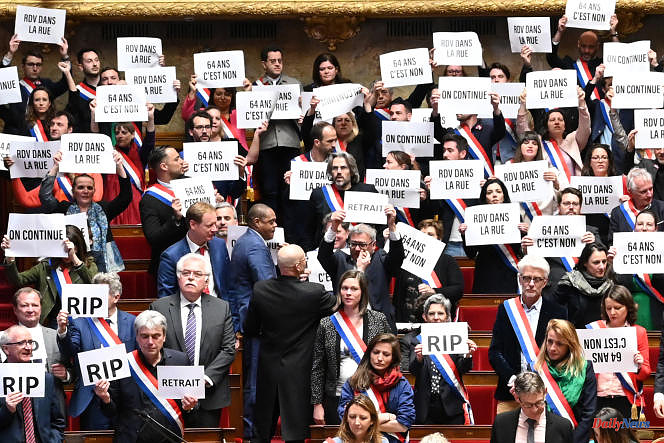After the tumultuous adoption of the pension reform by means of article 49.3 of the Constitution, the opposition parliamentarians continued the fight by trying to obtain the organization of a referendum of shared initiative (RIP). However, several steps are necessary before organizing a consultation of the French on this burning subject.
What are the steps before a possible referendum?
Until 2015, only the President of the Republic, on the proposal of the government or the assemblies, could call a referendum. Since the constitutional revision of 2008 and the organic law of 2015 implementing it, a referendum can be organized on the proposal of parliamentarians, confirmed by the signature of 10% of voters.
1. Support of a fifth of parliamentarians
Concretely, and above all, the RIP is a proposal that must be co-signed by at least 185 deputies and senators – one fifth of all parliamentarians. This condition was easily fulfilled for the pension reform.
From March 20, the day of the official adoption of the reform after the rejection of the motions of censure, more than 250 left-wing deputies and senators submitted a bill to the Constitutional Council aimed at "affirming that the legal age of departure retirement cannot be fixed beyond the age of 62". It is up "to the French people, by way of referendum, to be able to decide for or against the limitation of the legal age of retirement to 62 years", they write.
2. Validation by the Constitutional Council
The institution has one month to decide on the admissibility of the bill. In addition to the number of parliamentarians depositing it, the "wise men" verify that the text likely to be submitted to referendum falls within the criteria provided for by the Constitution. It must relate to "the organization of public powers, to reforms relating to the economic or social policy of the nation and to the public services which contribute thereto, or tending to authorize the ratification of a treaty".
Above all, the Constitutional Council must ensure that the bill does not "aim to repeal a legislative provision promulgated less than a year ago". Indeed, the RIP cannot be used to undo what Parliament has just voted. To judge its validity, it is the date of registration of the referendum initiative that must be taken into account, according to a decision of December 5, 2013 of the Constitutional Council.
Finally, the text submitted must not relate to the same subject as a bill rejected by referendum less than two years ago – which is not the case in this case.
3. Collection of 4.8 million signatures
If the text is deemed admissible by the Constitutional Council, it must receive the approval of 4.88 million signatures – one tenth of the number of voters registered on the electoral lists.
The collection of signatures, which extends over a period of nine months, is organized by the Ministry of the Interior, which must set up a dematerialized voting platform, but also allow each voter the possibility of depositing their support on paper by physically going to an access point installed in each canton.
The Constitutional Council then verifies the number and validity of the signatures. To be admissible, each support must fill out a form in which he states his identity, his address and the number of his identity card.
4. Review by Assemblies
If validated by 4.8 million voters, the bill must then be examined at least once by the two chambers of Parliament, the National Assembly and the Senate, within six months. Failing this, the President of the Republic submits the bill to a referendum.
Can the RIP block pension reform?
The Constitutional Council therefore has one month to validate the RIP proposal. But, as we have seen, the referendum cannot relate to the repeal of a legislative provision promulgated less than a year ago. The pension reform has certainly been adopted, but it has not yet been promulgated by the President of the Republic and can only be so before if – and when – it is validated by the Constitutional Council, seized by both the opposition and by the Prime Minister.
The same Constitutional Council therefore has the double task of validating the filing of the text that could lead to a RIP and of ruling on the constitutionality of a law that this same RIP could repeal.
The same parallel chronology situation arose in 2019, when a RIP proposal was submitted to oppose the privatization of Aéroports de Paris (ADP). In a decision of May 9, 2019, the Constitutional Council had validated the filing of the bill before validating the law targeted by the referendum text. However, this decision did not suspend the promulgation of the Pacte law on May 22, 2029, which included the provisions related to the privatization of ADP.
How many times has the RIP been used?
To date, no RIP has ever succeeded. Only the procedure on the privatization of ADP crossed the threshold of the support of a fifth of parliamentarians, in 2019, without succeeding in reaching a sufficient number of citizen signatures – it had collected 1.1 million signatures in nine months. If the privatization project has been postponed indefinitely, it is not linked to the RIP project, but to the difficulties in the air sector following the Covid-19 crisis.
In June 2020, the Constitutional Council had drawn up a critical assessment of the RIP, judging the procedure "dissuasive and difficult to read". He criticized in particular the difficulty of using the website provided for this purpose, and the discouraging aspect of the threshold of signatures to be reached, suggesting in the future to develop public information campaigns, or to create the conditions for a real democratic debate on the RIP proposal.
The current RIP is the form that comes closest to the citizens' initiative referendum (RIC), demanded since November 2018 by certain "yellow vests", which would not provide for a parliamentary lock upstream of the procedure, and would be conditioned on a much lower signature threshold. Other proposals for direct democracy emerged from their reflections, such as drawing lots or more open voting systems. On the occasion of the great national debate of 2019, most political groups in the Assembly and the Senate suggested reducing the threshold of the RIP to five million signatures.












